#aws aurora mysql
Explore tagged Tumblr posts
Text
Amazon Aurora Database Explained for AWS Cloud Developers
Full Video Link - https://youtube.com/shorts/4UD9t7-BzVM Hi, a new #video #tutorial on #amazonrds #aws #aurora #database #rds is published on #codeonedigest #youtube channel. @java @awscloud @AWSCloudIndia @YouTube #youtube @codeonedigest #cod
Amazon Aurora is a relational database management system (RDBMS) built for the cloud & gives you the performance, availability of commercial-grade databases at one-tenth the cost. Aurora database comes with MySQL & PostgreSQL compatibility. Amazon Aurora provides built-in security, continuous backups, serverless compute, up to 15 read replicas, automated multi-Region replication, and…
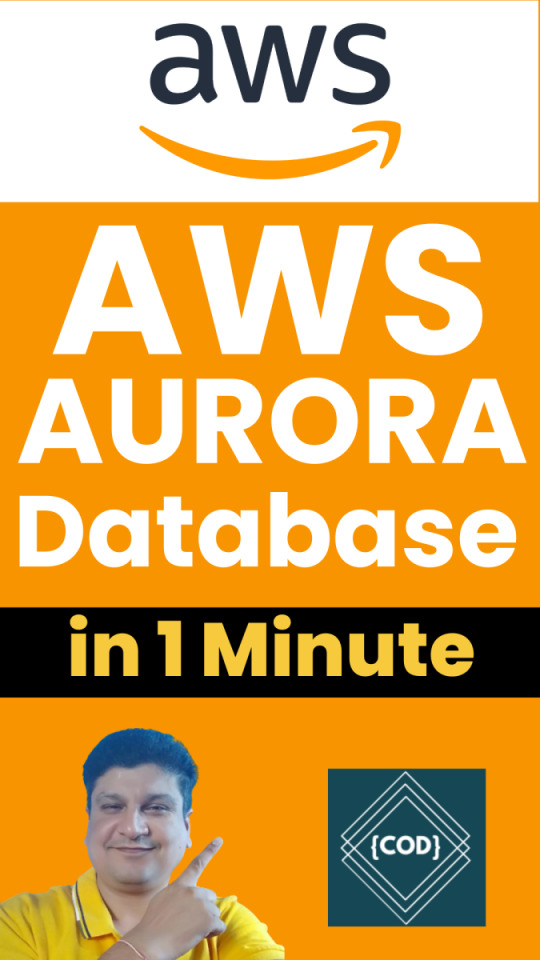
View On WordPress
#amazon aurora#amazon aurora mysql#amazon aurora postgresql#amazon aurora serverless#amazon aurora tutorial#amazon web services#amazon web services tutorial#aurora database aws#aurora database tutorial#aurora database vs rds#aurora db#aurora db aws#aurora db aws tutorial#aurora db cluster#aurora db with spring boot#aws#aws aurora#aws aurora mysql#aws aurora postgresql#aws aurora tutorial#aws aurora vs rds#aws cloud#what is amazon web services
0 notes
Text
Amazon RDS Extended Support for MySQL 5.7 & PostgreSQL 11
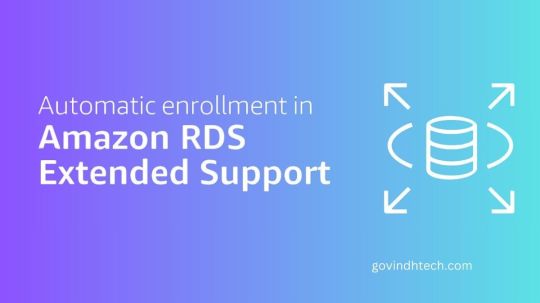
Your MySQL 5.7 and PostgreSQL 11 database instances on Amazon Aurora and Amazon RDS will automatically enroll in Amazon RDS Extended Support commencing February 29, 2024.
This will prevent unanticipated downtime and compatibility concerns from automated major version upgrades. You have more control over when to upgrade your major database.
RDS Extended Support may cost more due to automated enrollment. Upgrade your database before RDS Extended Support to prevent these expenses.
Describe Amazon RDS Extended Support
Amazon RDS Extended Support, announced in September 2023, lets you run your database on a major engine version on Amazon Aurora or Amazon RDS after its end of standard support date for a fee.
The MySQL and PostgreSQL open source communities identify CVEs, generate patches, and resolve bugs until community end of life (EoL). Until the database major version is retired, the communities release a quarterly minor version with security and bug updates. CVE patches and bug fixes are no longer available after the community end of life date, making such engines unsupported. As of October and November 2023, the communities no longer support MySQL 5.7 and PostgreSQL 11. AWS appreciate community support of these major versions and a transparent transition process and schedule to the latest major version.
Amazon Aurora and RDS engineer crucial CVE patches and bug fixes for up to three years after a major version’s community EoL with RDS Extended Support. Amazon Aurora and RDS will find engine CVEs and problems, develop patches, and deploy them swiftly for three years. Under RDS Extended Support, AWS will continue to support an engine’s major version after the open source community ends support, protecting your applications from severe security risks and unresolved problems.
You may ask why we charge for RDS Extended Support instead of including it in RDS. AWS must invest developer resources in crucial CVE patches and bug fixes to preserve community EoL engine security and functionality. Because of this, RDS Extended Support only charges clients that need the flexibility to stay on a version past its EoL.
If your applications depend on a specific MySQL or PostgreSQL major version for plug-in compatibility or bespoke functionality, RDS Extended Support may help you satisfy your business objectives. If you’re running on-premises database servers or self-managed Amazon Elastic Compute Cloud (Amazon EC2) instances, you can migrate to Amazon Aurora MySQL-Compatible Edition, Amazon Aurora PostgreSQL-Compatible Edition, Amazon RDS for MySQL, and Amazon RDS for PostgreSQL beyond the community EoL date and use them with RDS Extended Support in a managed service. RDS Extended Support lets you phase a large database transfer to ensure a smooth transition without straining IT resources.
RDS Extended Support will be provided in 2024 for RDS for MySQL 5.7, PostgreSQL 11, Aurora MySQL-compatible 2, and Aurora PostgreSQL 11. A supported MySQL major version on Amazon RDS and Amazon Aurora major versions in the AWS documentation lists all future supported versions.
Why are all databases automatically enrolled in Amazon RDS Extended Support?
AWS were told you RDS Extended Support would deliver opt-in APIs and console functionality in December 2023. AWS announced that if you did not opt your database into RDS Extended Support, it would automatically update to a newer engine version on March 1, 2024. You would be upgraded from Aurora MySQL 2 or RDS for MySQL 5.7 to Aurora MySQL 3 or RDS for MySQL 8.0, and from Aurora PostgreSQL 11 to 15 and RDS for 15.
However, several users complained that these automated upgrades may damage their applications and cause other unpredictable behavior between major community DB engine releases. If applications are not ready for MySQL 8.0 or PostgreSQL 15, an unplanned major version upgrade could cause compatibility issues or downtime.
Automatic enrollment in RDS Extended Support allows you more time and control to organize, schedule, and test database upgrades on your own timeline while receiving essential security and bug fixes from AWS.
Upgrade before RDS standard support ends to prevent automatic enrollment in RDS Extended Support and associated fees.
Upgrade your database to avoid RDS Extended Support fees
RDS Extended Support helps you schedule your upgrade, but staying with previous versions means missing out on the greatest price-performance for your database workload and paying more for support.
Global Database, Amazon RDS Proxy, Performance Insights, Parallel Query, and Serverless v2 deployments are supported in Aurora MySQL 8.0, also known as Aurora MySQL 3. RDS for MySQL 8.0 supports AWS Graviton2 and Graviton3-based instances, Multi-AZ cluster deployments, and Optimized Reads and Writes for up to three times better performance than MySQL 5.7.
Aurora PostgreSQL 15 Aurora I/O Optimized, Aurora Serverless v2, Babelfish for Aurora PostgreSQL, pgvector extension, TLE, AWS Graviton3-based instances, and community additions are supported by PostgreSQL. RDS for PostgreSQL 15 adds Multi-AZ DB cluster deployments, RDS Optimized Reads, HypoPG extension, pgvector extension, TLEs, and AWS Graviton3-based instances.
Major version upgrades may change databases incompatible with existing apps. To upgrade to the major version, manually edit your database. Any major version upgrade should be tested on non-production instances before being applied to production to verify application compatibility. The AWS documentation describes an in-place upgrade from MySQL 5.7 to 8.0, including incompatibilities, Aurora MySQL in-place major version upgrade, and RDS for MySQL upgrades. Use pgupgrade to upgrade PostgreSQL 11 to 15 in-places.
AWS advocate Fully Managed Blue/Green Deployments in Amazon Aurora and Amazon RDS to reduce upgrade downtime. Amazon RDS Blue/Green Deployments can establish a synchronized, fully controlled staging environment that mimics production in a few clicks. A parallel green environment with upper-version clones of your production databases lower-version is needed. Traffic might transition to the green environment after validation. Blue environment can be discontinued. Blue/Green Deployments reduce downtime best in most cases, except with Amazon Aurora and Amazon RDS.
Currently accessible
Amazon RDS Extended Support is now available for clients utilizing MySQL 5.7, PostgreSQL 11, and higher versions in AWS Regions, including AWS GovCloud (US), beyond the 2024 standard support expiration. You can upgrade your databases and obtain 3 years of RDS Extended Support without opting in.
Read more on Govindhtech.com
0 notes
Text
모듈 5
AWS 스토리지 및 데이터베이스 서비스 요약
AWS는 다양한 유형의 스토리지 및 데이터베이스 서비스를 제공하여 애플리케이션의 특정 요구 사항을 충족하도록 돕습니다.
1. 블록 스토리지
인스턴스 스토어 (Instance Store)
Amazon EC2 인스턴스에 임시 블록 수준 스토리지를 제공합니다.
EC2 인스턴스의 호스트 컴퓨터에 물리적으로 연결되어 인스턴스와 수명이 동일합니다.
인스턴스가 종료되면 데이터가 손실됩니다.
Amazon Elastic Block Store (Amazon EBS)
Amazon EC2 인스턴스에서 사용할 수 있는 영구적인 블록 수준 스토리지 볼륨을 제공합니다.
EC2 인스턴스가 중지 또는 종료되더라도 데이터를 보존합니다.
EBS 스냅샷을 생성하여 볼륨의 증분 백업을 수행할 수 있습니다. 증분 백업은 최초 백업 시 모든 데이터를 복사하고, 이후에는 변경된 데이터 블록만 저장합니다.
EBS 볼륨은 단일 가용 영역에 데이터를 저장하며, EC2 인스턴스와 동일한 가용 영역에 있어야 연결할 수 있습니다.
2. 객체 스토리지
객체 스토리지 개념
각 객체는 **데이터(파일), 메타데이터(정보), 키(고유 식별자)**로 구성됩니다.
Amazon Simple Storage Service (Amazon S3)
객체 수준 스토리지를 제공하는 서비스입니다.
데이터를 **버킷(Bucket)**에 객체로 저장합니다.
무제한의 저장 공간을 제공하며, 최대 객체 크기는 5TB입니다.
파일 업로드 시 권한을 설정하여 가시성 및 액세스를 제어할 수 있습니다.
버전 관리 기능을 통해 객체 변경 사항을 추적할 수 있습니다.
다양한 스토리지 클래스를 제공하며, 데이터 검색 빈도 및 가용성 요구 사항에 따라 선택합니다.
S3 Standard: 자주 액세스하는 데이터용. 최소 3개의 가용 영역에 저장되며 고가용성을 제공.
S3 Standard-Infrequent Access (S3 Standard-IA): 자주 액세스하지 않지만 고가용성이 필요한 데이터용. S3 Standard와 유사하지만 스토리지 비용이 저렴하고 검색 비용이 높음.
S3 One Zone-Infrequent Access (S3 One Zone-IA): 단일 가용 영역에 데이터를 저장. 스토리지 비용이 가장 저렴하지만, 가용 영역 장애 시 데이터가 손실될 수 있으므로 쉽게 재현 가능한 데이터에 적합.
S3 Intelligent-Tiering: 액세스 패턴을 알 수 없거나 자주 변하는 데이터용. 액세스 패턴을 모니터링하여 자주 액세스하지 않으면 자동으로 S3 Standard-IA로 이동시키고, 다시 액세스하면 S3 Standard로 이동.
S3 Glacier Instant Retrieval: 즉각적인 액세스가 필요한 아카이브 데이터용. 몇 밀리초 만에 객체 검색 가능.
S3 Glacier Flexible Retrieval: 데이터 보관용 저비용 스토리지. 몇 분에서 몇 시간 이내에 객체 검색.
S3 Glacier Deep Archive: 가장 저렴한 객체 스토리지 클래스로 장기 보관에 적합. 12시간 이내에 객체 검색. 3개 이상의 지리적으로 분산된 가용 영역에 복제.
S3 Outposts: 온프레미스 AWS Outposts 환경에 객체 스토리지를 제공. 데이터 근접성 및 로컬 데이터 레지던시 요구 사항이 있는 워크로드에 적합.
3. 파일 스토리지
파일 스토리지 개념
여러 클라이언트(사용자, 애플리케이션, 서버 등)가 공유 파일 폴더에 저장된 데이터에 액세스할 수 있습니다.
블록 스토리지를 로컬 파일 시스템과 함께 사용하여 파일을 구성하며, 클라이언트는 파일 경로를 통해 데이터에 액세스합니다.
많은 수의 서비스 및 리소스가 동시에 동일한 데이터에 액세스해야 하는 사용 사례에 이상적입니다.
Amazon Elastic File System (Amazon EFS)
AWS 클라우드 서비스 및 온프레미스 리소스와 함께 사용되는 확장 가능한 파일 시스템입니다.
파일 추가/제거 시 자동으로 확장 또는 축소됩니다.
리전별 서비스로, 여러 가용 영역에 걸쳐 데이터를 저장하여 고가용성을 제공합니다.
온프레미스 서버에서도 AWS Direct Connect를 통해 액세스할 수 있습니다.
4. 관계형 데이터베이스
관계형 데이터베이스 개념
데이터가 서로 관련된 방식으로 저장됩니다.
정형 쿼리 언어(SQL)를 사용하여 데이터를 저장하고 쿼리합니다.
데이터를 쉽게 ��해할 수 있고 일관되며 확장 가능한 방식으로 저장합니다.
Amazon Relational Database Service (Amazon RDS)
AWS 클라우드에서 관계형 데이터베이스를 실행할 수 있는 관리형 서비스입니다.
하드웨어 프로비저닝, 데이터베이스 설정, 패치 적용, 백업 등 관리 작업을 자동화합니다.
대부분의 데이터베이스 엔진이 저장 시 암호화 및 전송 중 암호화를 제공합니다.
지원 데이터베이스 엔진: Amazon Aurora, PostgreSQL, MySQL, MariaDB, Oracle Database, Microsoft SQL Server.
Amazon Aurora: 엔터프라이즈급 관계형 데이터베이스로, MySQL 및 PostgreSQL과 호환되며 표준 데이터베이스보다 최대 5배/3배 빠릅니다. 6개의 데이터 복사본을 3개의 가용 영역에 복제하고 Amazon S3에 지속적으로 백업하여 고가용성을 제공합니다.
5. 비관계형 (NoSQL) 데이터베이스
비관계형 데이터베이스 개념
행과 열이 아닌 다른 구조를 사용하여 데이터를 구성합니다. (예: 키-값 페어)
테이블의 항목에서 속성을 자유롭게 추가/제거할 수 있으며, 모든 항목에 동일한 속성이 있어야 하는 것은 아닙니다.
Amazon DynamoDB
키-값 데이터베이스 서비스입니다.
모든 규모에서 한 자릿수 밀리초의 성능을 제공합니다.
서버리스이므로 서버 프로비저닝, 패치 적용, 관리 등이 필요 없습니다.
자동 크기 조정 기능을 통해 용량 변화에 맞춰 자동으로 크기를 조정하며 일관된 성능을 유지합니다.
6. 데이터 웨어하우징 및 마이그레이션
Amazon Redshift
빅 데이터 분석에 사용되는 데이터 웨어하우징 서비스입니다.
여러 원본에서 데이터를 수집하여 관계 및 추세 파악을 돕는 기능을 제공합니다.
AWS Database Migration Service (AWS DMS)
관계형 데이터베이스, 비관계형 데이터베이스 및 기타 데이터 저장소를 마이그레이션할 수 있는 서비스입니다.
원본과 대상 데이터베이스 유형이 달라도 마이그레이션이 가능하며, 마이그레이션 중 원본 데이터베이스의 가동 중지 시간을 줄일 수 있습니다.
주요 사용 사례: 개발/테스트 데이터베이스 마이그레이션, 데이터베이스 통합, 연속 복제.
7. 추가 데이터베이스 서비스
Amazon DocumentDB: MongoDB 워크로드를 지원하는 문서 데이터베이스 서비스.
Amazon Neptune: 그래프 데이터베이스 서비스. 추천 엔진, 사기 탐지, 지식 그래프 등 고도로 연결된 데이터 세트로 작동하는 애플리케이션에 적합.
Amazon Quantum Ledger Database (Amazon QLDB): 원장 데이터베이스 서비스. 애플리케이션 데이터의 모든 변경 사항에 대한 전체 기록을 검토 가능.
Amazon Managed Blockchain: 오픈 소스 프레임워크를 사용하여 블록체인 네트워크를 생성하고 관리.
Amazon ElastiCache: 데이터베이스 위에 캐싱 계층을 추가하여 자주 사용되는 요청의 읽기 시간을 향상. Redis 및 Memcached 지원.
Amazon DynamoDB Accelerator (DAX): DynamoDB용 인 메모리 캐시. 응답 시간을 밀리초에서 마이크로초��지 향상.
0 notes
Text
U.S. Cloud DBaaS Market Set for Explosive Growth Amid Digital Transformation Through 2032
Cloud Database And DBaaS Market was valued at USD 17.51 billion in 2023 and is expected to reach USD 77.65 billion by 2032, growing at a CAGR of 18.07% from 2024-2032.
Cloud Database and DBaaS Market is witnessing accelerated growth as organizations prioritize scalability, flexibility, and real-time data access. With the surge in digital transformation, U.S.-based enterprises across industries—from fintech to healthcare—are shifting from traditional databases to cloud-native solutions that offer seamless performance and cost efficiency.
U.S. Cloud Database & DBaaS Market Sees Robust Growth Amid Surge in Enterprise Cloud Adoption
U.S. Cloud Database And DBaaS Market was valued at USD 4.80 billion in 2023 and is expected to reach USD 21.00 billion by 2032, growing at a CAGR of 17.82% from 2024-2032.
Cloud Database and DBaaS Market continues to evolve with strong momentum in the USA, driven by increasing demand for managed services, reduced infrastructure costs, and the rise of multi-cloud environments. As data volumes expand and applications require high availability, cloud database platforms are emerging as strategic assets for modern enterprises.
Get Sample Copy of This Report: https://www.snsinsider.com/sample-request/6586
Market Keyplayers:
Google LLC (Cloud SQL, BigQuery)
Nutanix (Era, Nutanix Database Service)
Oracle Corporation (Autonomous Database, Exadata Cloud Service)
IBM Corporation (Db2 on Cloud, Cloudant)
SAP SE (HANA Cloud, Data Intelligence)
Amazon Web Services, Inc. (RDS, Aurora)
Alibaba Cloud (ApsaraDB for RDS, ApsaraDB for MongoDB)
MongoDB, Inc. (Atlas, Enterprise Advanced)
Microsoft Corporation (Azure SQL Database, Cosmos DB)
Teradata (VantageCloud, ClearScape Analytics)
Ninox (Cloud Database, App Builder)
DataStax (Astra DB, Enterprise)
EnterpriseDB Corporation (Postgres Cloud Database, BigAnimal)
Rackspace Technology, Inc. (Managed Database Services, Cloud Databases for MySQL)
DigitalOcean, Inc. (Managed Databases, App Platform)
IDEMIA (IDway Cloud Services, Digital Identity Platform)
NEC Corporation (Cloud IaaS, the WISE Data Platform)
Thales Group (CipherTrust Cloud Key Manager, Data Protection on Demand)
Market Analysis
The Cloud Database and DBaaS (Database-as-a-Service) Market is being fueled by a growing need for on-demand data processing and real-time analytics. Organizations are seeking solutions that provide minimal maintenance, automatic scaling, and built-in security. U.S. companies, in particular, are leading adoption due to strong cloud infrastructure, high data dependency, and an agile tech landscape.
Public cloud providers like AWS, Microsoft Azure, and Google Cloud dominate the market, while niche players continue to innovate in areas such as serverless databases and AI-optimized storage. The integration of DBaaS with data lakes, containerized environments, and AI/ML pipelines is redefining the future of enterprise database management.
Market Trends
Increased adoption of multi-cloud and hybrid database architectures
Growth in AI-integrated database services for predictive analytics
Surge in serverless DBaaS models for agile development
Expansion of NoSQL and NewSQL databases to support unstructured data
Data sovereignty and compliance shaping platform features
Automated backup, disaster recovery, and failover features gaining popularity
Growing reliance on DBaaS for mobile and IoT application support
Market Scope
The market scope extends beyond traditional data storage, positioning cloud databases and DBaaS as critical enablers of digital agility. Businesses are embracing these solutions not just for infrastructure efficiency, but for innovation acceleration.
Scalable and elastic infrastructure for dynamic workloads
Fully managed services reducing operational complexity
Integration-ready with modern DevOps and CI/CD pipelines
Real-time analytics and data visualization capabilities
Seamless migration support from legacy systems
Security-first design with end-to-end encryption
Forecast Outlook
The Cloud Database and DBaaS Market is expected to grow substantially as U.S. businesses increasingly seek cloud-native ecosystems that deliver both performance and adaptability. With a sharp focus on automation, real-time access, and AI-readiness, the market is transforming into a core element of enterprise IT strategy. Providers that offer interoperability, data resilience, and compliance alignment will stand out as leaders in this rapidly advancing space.
Access Complete Report: https://www.snsinsider.com/reports/cloud-database-and-dbaas-market-6586
Conclusion
The future of data is cloud-powered, and the Cloud Database and DBaaS Market is at the forefront of this transformation. As American enterprises accelerate their digital journeys, the demand for intelligent, secure, and scalable database services continues to rise.
Related Reports:
Analyze U.S. market demand for advanced cloud security solutions
Explore trends shaping the Cloud Data Security Market in the U.S
About Us:
SNS Insider is one of the leading market research and consulting agencies that dominates the market research industry globally. Our company's aim is to give clients the knowledge they require in order to function in changing circumstances. In order to give you current, accurate market data, consumer insights, and opinions so that you can make decisions with confidence, we employ a variety of techniques, including surveys, video talks, and focus groups around the world.
Contact Us:
Jagney Dave - Vice President of Client Engagement
Phone: +1-315 636 4242 (US) | +44- 20 3290 5010 (UK)
0 notes
Text
Azure vs. AWS: A Detailed Comparison
Cloud computing has become the backbone of modern IT infrastructure, offering businesses scalability, security, and flexibility. Among the top cloud service providers, Microsoft Azure and Amazon Web Services (AWS) dominate the market, each bringing unique strengths. While AWS has held the position as a cloud pioneer, Azure has been gaining traction, especially among enterprises with existing Microsoft ecosystems. This article provides an in-depth comparison of Azure vs. AWS, covering aspects like database services, architecture, and data engineering capabilities to help businesses make an informed decision.
1. Market Presence and Adoption
AWS, launched in 2006, was the first major cloud provider and remains the market leader. It boasts a massive customer base, including startups, enterprises, and government organizations. Azure, introduced by Microsoft in 2010, has seen rapid growth, especially among enterprises leveraging Microsoft's ecosystem. Many companies using Microsoft products like Windows Server, SQL Server, and Office 365 find Azure a natural choice.
2. Cloud Architecture: Comparing Azure and AWS
Cloud architecture defines how cloud services integrate and support workloads. Both AWS and Azure provide robust cloud architectures but with different approaches.
AWS Cloud Architecture
AWS follows a modular approach, allowing users to pick and choose services based on their needs. It offers:
Amazon EC2 for scalable compute resources
Amazon VPC for network security and isolation
Amazon S3 for highly scalable object storage
AWS Lambda for serverless computing
Azure Cloud Architecture
Azure's architecture is designed to integrate seamlessly with Microsoft tools and services. It includes:
Azure Virtual Machines (VMs) for compute workloads
Azure Virtual Network (VNet) for networking and security
Azure Blob Storage for scalable object storage
Azure Functions for serverless computing
In terms of architecture, AWS provides more flexibility, while Azure ensures deep integration with enterprise IT environments.
3. Database Services: Azure SQL vs. AWS RDS
Database management is crucial for any cloud strategy. Both AWS and Azure offer extensive database solutions, but they cater to different needs.
AWS Database Services
AWS provides a wide range of managed database services, including:
Amazon RDS (Relational Database Service) – Supports MySQL, PostgreSQL, SQL Server, MariaDB, and Oracle.
Amazon Aurora – High-performance relational database compatible with MySQL and PostgreSQL.
Amazon DynamoDB – NoSQL database for low-latency applications.
Amazon Redshift – Data warehousing for big data analytics.
Azure Database Services
Azure offers strong database services, especially for Microsoft-centric workloads:
Azure SQL Database – Fully managed SQL database optimized for Microsoft applications.
Cosmos DB – Globally distributed, multi-model NoSQL database.
Azure Synapse Analytics – Enterprise-scale data warehousing.
Azure Database for PostgreSQL/MySQL/MariaDB – Open-source relational databases with managed services.
AWS provides a more mature and diverse database portfolio, while Azure stands out in SQL-based workloads and seamless Microsoft integration.
4. Data Engineering and Analytics: Which Cloud is Better?
Data engineering is a critical function that ensures efficient data processing, transformation, and storage. Both AWS and Azure offer data engineering tools, but their capabilities differ.
AWS Data Engineering Tools
AWS Glue – Serverless data integration service for ETL workloads.
Amazon Kinesis – Real-time data streaming.
AWS Data Pipeline – Orchestration of data workflows.
Amazon EMR (Elastic MapReduce) – Managed Hadoop, Spark, and Presto.
Azure Data Engineering Tools
Azure Data Factory – Cloud-based ETL and data integration.
Azure Stream Analytics – Real-time event processing.
Azure Databricks – Managed Apache Spark for big data processing.
Azure HDInsight – Fully managed Hadoop and Spark services.
Azure has an edge in data engineering for enterprises leveraging AI and machine learning via Azure Machine Learning and Databricks. AWS, however, excels in scalable and mature big data tools.
5. Pricing Models and Cost Efficiency
Cloud pricing is a major factor when selecting a provider. Both AWS and Azure offer pay-as-you-go pricing, reserved instances, and cost optimization tools.
AWS Pricing: Charges are based on compute, storage, data transfer, and additional services. AWS also offers AWS Savings Plans for cost reductions.
Azure Pricing: Azure provides cost-effective solutions for Microsoft-centric businesses. Azure Hybrid Benefit allows companies to use existing Windows Server and SQL Server licenses to save costs.
AWS generally provides more pricing transparency, while Azure offers better pricing for Microsoft users.
6. Security and Compliance
Security is a top priority in cloud computing, and both AWS and Azure provide strong security measures.
AWS Security: Uses AWS IAM (Identity and Access Management), AWS Shield (DDoS protection), and AWS Key Management Service.
Azure Security: Provides Azure Active Directory (AAD), Azure Security Center, and built-in compliance features for enterprises.
Both platforms meet industry standards like GDPR, HIPAA, and ISO 27001, making them secure choices for businesses.
7. Hybrid Cloud Capabilities
Enterprises increasingly prefer hybrid cloud strategies. Here, Azure has a significant advantage due to its Azure Arc and Azure Stack technologies that extend cloud services to on-premises environments.
AWS offers AWS Outposts, but it is not as deeply integrated as Azure’s hybrid solutions.
8. Which Cloud Should You Choose?
Choose AWS if:
You need a diverse range of cloud services.
You require highly scalable and mature cloud solutions.
Your business prioritizes flexibility and a global cloud footprint.
Choose Azure if:
Your business relies heavily on Microsoft products.
You need strong hybrid cloud capabilities.
Your focus is on SQL-based workloads and enterprise data engineering.
Conclusion
Both AWS and Azure are powerful cloud providers with unique strengths. AWS remains the leader in cloud services, flexibility, and scalability, while Azure is the go-to choice for enterprises using Microsoft’s ecosystem.
Ultimately, the right choice depends on your organization’s needs in terms of database management, cloud architecture, data engineering, and overall IT strategy. Companies looking for a seamless Microsoft integration should opt for Azure, while businesses seeking a highly scalable and service-rich cloud should consider AWS.
Regardless of your choice, both platforms provide the foundation for a strong, scalable, and secure cloud infrastructure in today’s data-driven world.
0 notes
Text
AWS Modernization: Ambitiously Rejuvenating the Cloud Journey with Innovation
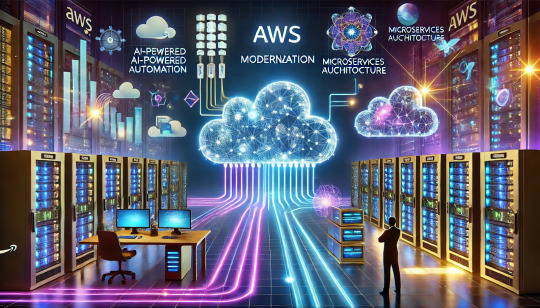
Firms are all rushing towards the cloud-basted solution due to massive demand for agility, cost-effectiveness, and innovation within this fast-paced digital epoch. AWS offers innovation solutions to modernize legacy architecture, optimize workloads and achieve operational excellence. This blog analyzes the features of some top AWS modernization services, showing how they can change the course of your cloud journey.
1. AWS Lambda
AWS Lambda is a serverless computing service that runs code without having to provision or manage servers. It scales automatically according to demand, so you can build scalable applications and reduce the infrastructure complexity.
2. Amazon ECS and EKS
Modernization of application deployment is now easier with Amazon ECS and EKS. This allows organizations to move towards containerization, has simplified application management, and assures scalability across environments.
3. AWS Fargate
AWS Fargate is a serverless compute engine for containers that eliminated the need for server management; therefore, the developers can focus on just developing apps. This not only optimizes resource use due to pay-as-you-go pricing and automatic scaling.
4. Amazon Aurora
Amazon Aurora is an extremely high-performing, resilient cloud-native relational database service that is compatible with open-source engines MySQL and PostgreSQL, making the tool ideal for any organization looking to migrate databases.
5. AWS Application Migration Service
The AWS Application Migration Service (AWS MGN) makes it easier to move applications from on-premises to AWS. It automates significant parts of the migration process and minimizes downtime.
6. AWS DevOps Tools
AWS has matured in terms of using numerous development tools, from AWS CodePipeline, AWS CodeBuild, and AWS CodeDeploy, that allow for continuous integration and continuous delivery (CI/CD), thus minimizing changes to development cycle times and effectiveness of deployment.
7. AWS Modernization Hub
The AWS Modernization Hub is a one-stop solution for the planning and execution of modernization projects. It provides insights, resources, and guidance toward fine-tuning modern architecture migration.
Utilization of AWS modernization solutions keeps organizations at the forefront, innovating ahead of time and optimizing business processes. With serverless computing, containerization, and automated migrations, AWS is the secret to your future-proof cloud. Using these very available solutions, organizations can create new avenues for growth and digital transform.
Conclusion
AWS modernization is a wholesale cleanup and not merely an upgrade in technologies for an enterprise to innovate, simplify, and expand at speed. The adoption of cloud-native architectures, serverless architectures, AI-driven automations, and DevOps practices envelop these capabilities with new levels of efficiency, security, and cost-competitiveness.
With this ambitious reimagination of the cloud experience, organizations are capable of taking the lead in the fast-paced competition of the digital world. Scaling modernization is assured with AWS tooling and frameworks, no matter if it is based on microservices, containerization, or machine learning integration.
Cloud innovation is endless. Organizations that respond nimbly and continuously update their AWS strategies will continue to prosper, taking advantage of the latest technologies in pursuing business growth and stability.
1 note
·
View note
Video
youtube
Amazon RDS Performance Insights | Monitor and Optimize Database Performance
Amazon RDS Performance Insights is an advanced monitoring tool that helps you analyze and optimize your database workload in Amazon RDS and Amazon Aurora. It provides real-time insights into database performance, making it easier to identify bottlenecks and improve efficiency without deep database expertise.
Key Features of Amazon RDS Performance Insights:
✅ Automated Performance Monitoring – Continuously collects and visualizes performance data to help you monitor database load. ✅ SQL Query Analysis – Identifies slow-running queries, so you can optimize them for better database efficiency. ✅ Database Load Metrics – Displays a simple Database Load (DB Load) graph, showing the active sessions consuming resources. ✅ Multi-Engine Support – Compatible with MySQL, PostgreSQL, SQL Server, MariaDB, and Amazon Aurora. ✅ Retention & Historical Analysis – Stores performance data for up to two years, allowing trend analysis and long-term optimization. ✅ Integration with AWS Services – Works seamlessly with Amazon CloudWatch, AWS Lambda, and other AWS monitoring tools.
How Amazon RDS Performance Insights Helps You:
🔹 Troubleshoot Performance Issues – Quickly diagnose and fix slow queries, high CPU usage, or locked transactions. 🔹 Optimize Database Scaling – Understand workload trends to scale your database efficiently. 🔹 Enhance Application Performance – Ensure your applications run smoothly by reducing database slowdowns. 🔹 Improve Cost Efficiency – Optimize resource utilization to prevent over-provisioning and reduce costs.
How to Enable Amazon RDS Performance Insights: 1️⃣ Navigate to AWS Management Console. 2️⃣ Select Amazon RDS and choose your database instance. 3️⃣ Click on Modify, then enable Performance Insights under Monitoring. 4️⃣ Choose the retention period (default 7 days, up to 2 years with paid plans). 5️⃣ Save changes and start analyzing real-time database performance!
Who Should Use Amazon RDS Performance Insights? 🔹 Database Administrators (DBAs) – To manage workload distribution and optimize database queries. 🔹 DevOps Engineers – To ensure smooth database operations for applications running on AWS. 🔹 Developers – To analyze slow queries and improve app performance. 🔹 Cloud Architects – To monitor resource utilization and plan database scaling effectively.
Amazon RDS Performance Insights simplifies database monitoring, making it easy to detect issues and optimize workloads for peak efficiency. Start leveraging it today to improve the performance and scalability of your AWS database infrastructure! 🚀
**************************** *Follow Me* https://www.facebook.com/cloudolus/ | https://www.facebook.com/groups/cloudolus | https://www.linkedin.com/groups/14347089/ | https://www.instagram.com/cloudolus/ | https://twitter.com/cloudolus | https://www.pinterest.com/cloudolus/ | https://www.youtube.com/@cloudolus | https://www.youtube.com/@ClouDolusPro | https://discord.gg/GBMt4PDK | https://www.tumblr.com/cloudolus | https://cloudolus.blogspot.com/ | https://t.me/cloudolus | https://www.whatsapp.com/channel/0029VadSJdv9hXFAu3acAu0r | https://chat.whatsapp.com/BI03Rp0WFhqBrzLZrrPOYy *****************************
*🔔Subscribe & Stay Updated:* Don't forget to subscribe and hit the bell icon to receive notifications and stay updated on our latest videos, tutorials & playlists! *ClouDolus:* https://www.youtube.com/@cloudolus *ClouDolus AWS DevOps:* https://www.youtube.com/@ClouDolusPro *THANKS FOR BEING A PART OF ClouDolus! 🙌✨*
#youtube#AmazonRDS RDSPerformanceInsights DatabaseOptimization AWSDevOps ClouDolus CloudComputing PerformanceMonitoring SQLPerformance CloudDatabase#amazon rds database S3 aws devops amazonwebservices free awscourse awstutorial devops awstraining cloudolus naimhossenpro ssl storage cloudc
0 notes
Text
AWS RDS: Simplifying Database Management in the Cloud
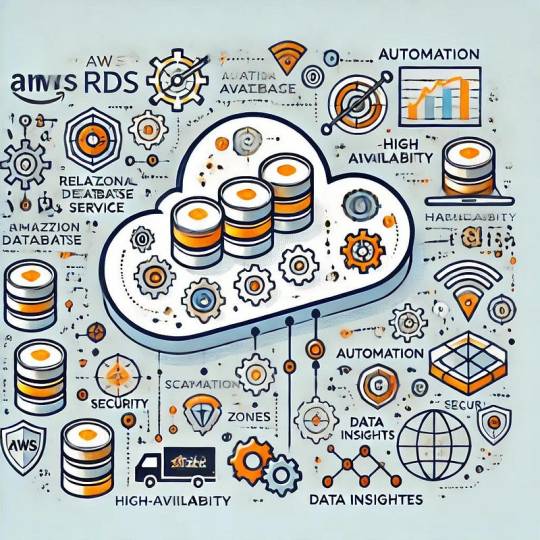
AWS RDS: Simplifying Database Management in the Cloud Amazon Relational Database Service (AWS RDS) is a fully managed service that makes setting up, operating, and scaling relational databases in the cloud simple and efficient.
AWS RDS supports popular database engines such as MySQL, PostgreSQL, Oracle, SQL Server, MariaDB, and Amazon Aurora, offering users flexibility in choosing the right database for their applications.
Key Features:
Automated Management: RDS handles routine database tasks like backups, patching, and scaling, reducing operational overhead.
High Availability: With Multi-AZ (Availability Zone) deployments, RDS ensures failover support and business continuity.
Scalability: It allows seamless scaling of database storage and compute resources to meet changing demands.
Security: Offers encryption at rest and in transit, along with integration with AWS IAM and VPC for access control.
Monitoring: Provides performance insights and integration with Amazon CloudWatch for tracking database health and metrics.
Benefits: Reduces the complexity of managing on-premises databases.
Saves time with automatic provisioning and maintenance.
Supports disaster recovery and high availability, crucial for modern applications.
Common Use Cases:
E-commerce platforms with MySQL or PostgreSQL databases.
Analytics applications using Amazon Aurora for faster query performance. Enterprise applications relying on SQL Server or Oracle databases.
AWS RDS is an ideal solution for developers and businesses looking to focus on building applications rather than managing databases.
WEBSITE: https://www.ficusoft.in/aws-training-in-chennai/
0 notes
Text
Comparing Amazon RDS and Aurora: Key Differences Explained
When it comes to choosing a database solution in the cloud, Amazon Web Services (AWS) offers a range of powerful options, with Amazon Relational Database Service (RDS) and Amazon Aurora being two of the most popular. Both services are designed to simplify database management, but they cater to different needs and use cases. In this blog, we’ll delve into the key differences between Amazon RDS and Aurora to help you make an informed decision for your applications.
If you want to advance your career at the AWS Course in Pune, you need to take a systematic approach and join up for a course that best suits your interests and will greatly expand your learning path.
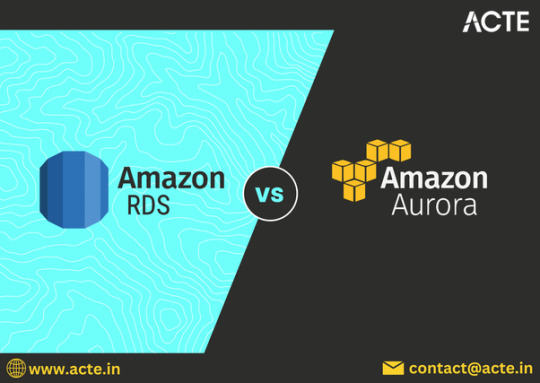
What is Amazon RDS?
Amazon RDS is a fully managed relational database service that supports multiple database engines, including MySQL, PostgreSQL, MariaDB, Oracle, and Microsoft SQL Server. It automates routine database tasks such as backups, patching, and scaling, allowing developers to focus more on application development rather than database administration.
Key Features of RDS
Multi-Engine Support: Choose from various database engines to suit your specific application needs.
Automated Backups: RDS automatically backs up your data and provides point-in-time recovery.
Read Replicas: Scale read operations by creating read replicas to offload traffic from the primary instance.
Security: RDS offers encryption at rest and in transit, along with integration with AWS Identity and Access Management (IAM).
What is Amazon Aurora?
Amazon Aurora is a cloud-native relational database designed for high performance and availability. It is compatible with MySQL and PostgreSQL, offering enhanced features that improve speed and reliability. Aurora is built to handle demanding workloads, making it an excellent choice for large-scale applications.
Key Features of Aurora
High Performance: Aurora can deliver up to five times the performance of standard MySQL databases, thanks to its unique architecture.
Auto-Scaling Storage: Automatically scales storage from 10 GB to 128 TB without any downtime, adapting to your needs seamlessly.
High Availability: Data is automatically replicated across multiple Availability Zones for robust fault tolerance and uptime.
Serverless Option: Aurora Serverless automatically adjusts capacity based on application demand, ideal for unpredictable workloads.
To master the intricacies of AWS and unlock its full potential, individuals can benefit from enrolling in the AWS Online Training.
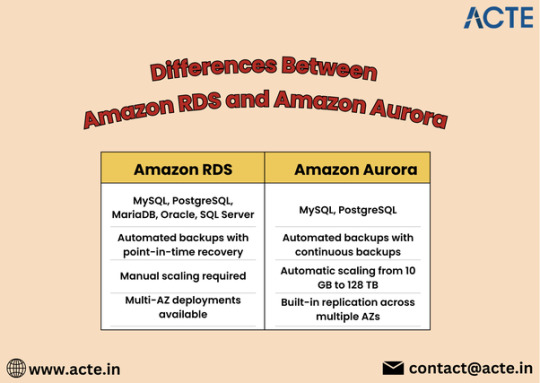
Key Differences Between Amazon RDS and Aurora
1. Performance and Scalability
One of the most significant differences lies in performance. Aurora is engineered for high throughput and low latency, making it a superior choice for applications that require fast data access. While RDS provides good performance, it may not match the efficiency of Aurora under heavy loads.
2. Cost Structure
Both services have different pricing models. RDS typically has a more straightforward pricing structure based on instance types and storage. Aurora, however, incurs costs based on the volume of data stored, I/O operations, and instance types. While Aurora may seem more expensive initially, its performance gains can result in cost savings for high-traffic applications.
3. High Availability and Fault Tolerance
Aurora inherently offers better high availability due to its design, which replicates data across multiple Availability Zones. While RDS does offer Multi-AZ deployments for high availability, Aurora’s replication and failover mechanisms provide additional resilience.
4. Feature Set
Aurora includes advanced features like cross-region replication and global databases, which are not available in standard RDS. These capabilities make Aurora an excellent option for global applications that require low-latency access across regions.
5. Management and Maintenance
Both services are managed by AWS, but Aurora requires less manual intervention for scaling and maintenance due to its automated features. This can lead to reduced operational overhead for businesses relying on Aurora.
When to Choose RDS or Aurora
Choose Amazon RDS if you need a straightforward, managed relational database solution with support for multiple engines and moderate performance needs.
Opt for Amazon Aurora if your application demands high performance, scalability, and advanced features, particularly for large-scale or global applications.
Conclusion
Amazon RDS and Amazon Aurora both offer robust solutions for managing relational databases in the cloud, but they serve different purposes. Understanding the key differences can help you select the right service based on your specific requirements. Whether you go with the simplicity of RDS or the advanced capabilities of Aurora, AWS provides the tools necessary to support your database needs effectively.
0 notes
Text
Scaling E-commerce with AWS Aurora: Efficiency and Reliability
Building a Scalable E-commerce Platform with AWS Aurora Introduction In this tutorial, we will walk through the process of building a scalable e-commerce platform using AWS Aurora, a MySQL-compatible relational database service offered by Amazon Web Services (AWS). A scalable e-commerce platform is crucial for businesses that want to handle large volumes of traffic and transactions while…
0 notes
Text
AWS Aurora vs RDS: An In-Depth Comparison

AWS Aurora vs. RDS
Amazon Web Services (AWS) offers a range of database solutions, among which Amazon Aurora and Amazon Relational Database Service (RDS) are prominent choices for relational database management. While both services cater to similar needs, they have distinct features, performance characteristics, and use cases. This comparison will help you understand the differences and make an informed decision based on your specific requirements.
What is Amazon RDS?
Amazon RDS is a managed database service that supports several database engines, including MySQL, PostgreSQL, MariaDB, Oracle, and Microsoft SQL Server. RDS simplifies the process of setting up, operating, and scaling a relational database in the cloud by automating tasks such as hardware provisioning, database setup, patching, and backups.
What is Amazon Aurora?
Amazon Aurora is a MySQL and PostgreSQL-compatible relational database built for the cloud, combining the performance and availability of high-end commercial databases with the simplicity and cost-effectiveness of open-source databases. Aurora is designed to deliver high performance and reliability, with some advanced features that set it apart from standard RDS offerings.
Performance
Amazon RDS: Performance depends on the selected database engine and instance type. It provides good performance for typical workloads but may require manual tuning and optimization.
Amazon Aurora: Designed for high performance, Aurora can deliver up to five times the throughput of standard MySQL and up to three times the throughput of standard PostgreSQL databases. It achieves this through distributed, fault-tolerant, and self-healing storage that is decoupled from compute resources.
Scalability
Amazon RDS: Supports vertical scaling by upgrading the instance size and horizontal scaling through read replicas. However, the scaling process may involve downtime and requires careful planning.
Amazon Aurora: Offers seamless scalability with up to 15 low-latency read replicas, and it can automatically adjust the storage capacity without affecting database performance. Aurora’s architecture allows it to scale out and handle increased workloads more efficiently.
Availability and Durability
Amazon RDS: Provides high availability through Multi-AZ deployments, where a standby replica is maintained in a different Availability Zone. In case of a primary instance failure, RDS automatically performs a failover to the standby replica.
Amazon Aurora: Enhances availability with six-way replication across three Availability Zones and automated failover mechanisms. Aurora’s storage is designed to be self-healing, with continuous backups to Amazon S3 and automatic repair of corrupted data blocks.
Cost
Amazon RDS: Generally more cost-effective for smaller, less demanding workloads. Pricing depends on the chosen database engine, instance type, and storage requirements.
Amazon Aurora: Slightly more expensive than RDS due to its advanced features and higher performance capabilities. However, it can be more cost-efficient for large-scale, high-traffic applications due to its performance and scaling advantages.
Maintenance and Management
Amazon RDS: Offers automated backups, patching, and minor version upgrades. Users can manage various configuration settings and maintenance windows, but they must handle some aspects of database optimization.
Amazon Aurora: Simplifies maintenance with continuous backups, automated patching, and seamless version upgrades. Aurora also provides advanced monitoring and diagnostics through Amazon CloudWatch and Performance Insights.
Use Cases
Amazon RDS: Suitable for a wide range of applications, including small to medium-sized web applications, development and testing environments, and enterprise applications that do not require extreme performance or scalability.
Amazon Aurora: Ideal for mission-critical applications that demand high performance, scalability, and availability, such as e-commerce platforms, financial systems, and large-scale enterprise applications. Aurora is also a good choice for organizations looking to migrate from commercial databases to a more cost-effective cloud-native solution.
Conclusion
Amazon Aurora vs Amazon RDS both offer robust, managed database solutions in the AWS ecosystem. RDS provides flexibility with multiple database engines and is well-suited for typical workloads and smaller applications. Aurora, on the other hand, excels in performance, scalability, and availability, making it the preferred choice for demanding and large-scale applications. Choosing between RDS and Aurora depends on your specific needs, performance requirements, and budget considerations.
0 notes
Text
What Is Amazon RDS? Amazon RDS Best Practices, Benefits

What is Amazon RDS?
The service for relational databases Designed to minimize total cost of ownership, Amazon Relational Database Service (Amazon RDS) is easy to use. Setting up, running, and scaling to meet demand is easy. Tasks related to provisioning, configuration, backup, and patching are among the undifferentiated database management tasks that are automated by Amazon RDS. With Amazon RDS, users can quickly establish a new database and personalize it to suit their needs using two deployment options and eight engines. Customers can optimize performance with features including AWS Graviton3-based instances, optimized writes and reads, and Multi-AZ with two readable standbys. They can also select from a variety of pricing choices to efficiently control expenses.
New developments with Amazon RDS
Aurora
Fully compatible with MySQL and PostgreSQL, Amazon Aurora offers unmatched performance and availability on a global scale for a tenth of the price of commercial databases. With features like Amazon Aurora Serverless, which can scale to hundreds of thousands of transactions in a split second, Amazon Aurora I/O-Optimized, which predicts prices, and zero-ETL integrations to Amazon Redshift, which provide near-real-time analytics on your transactional data, you can take advantage of improved capabilities that delight your users.
The Amazon RDS
When you utilize Amazon RDS, you may start using the same commercial and open source database software that you are accustomed to and trust, like MariaDB, PostgreSQL, MySQL, SQL Server, Oracle, and Db2. With support for AWS Graviton3-based instances, Amazon Elastic Block Store (Amazon EBS), and io2 Block Express storage, you can take advantage of the innovation of the AWS stack and eliminate the burden of undifferentiated administrative duties.
Creating applications for generative AI
The performance of your generative AI applications can be enhanced by using Amazon Relational Database Service (Amazon RDS) for PostgreSQL and Amazon Aurora PostgreSQL-Compatible Edition. You can accomplish 20 times better queries per second than with pgvector_IVFFLAT when you combine the capabilities of Amazon Aurora Optimized Reads and pgvector_hnsw.
ML and analytics with integrations at zero ETL
With zero-ETL integrations, the laborious task of creating and overseeing ETL pipelines from live databases to data warehouses is eliminated. In order to achieve desired business objectives, zero-ETL enables clients to access their transactional data in almost real-time for analytics and machine learning (ML) purposes.
Possibilities for deployment
Deployment choices are flexible with Amazon RDS. Applications that need to customize the underlying database environment and operating system can benefit from the managed experience offered by Amazon Relational Database Service (Amazon RDS) Custom. Fully managed database instances can be set up in your on-premises environments using Amazon Relational Database Service (Amazon RDS) on AWS Outposts.
Use Cases
Construct mobile and web applications
Provide high availability, throughput, and storage scalability to accommodate expanding apps. Utilize adaptable pay-per-use pricing to accommodate different application usage trends.
Use managed databases instead
Instead of worrying about self-managing your databases, which may be costly, time-consuming, and complex, experiment and create new apps with Amazon RDS.
Become independent of legacy databases
By switching to Aurora, you can get rid of costly, punitive, commercial databases. When you switch to Aurora, you can obtain commercial databases’ scalability, performance, and availability for a tenth of the price.
Amazon RDS advantages
One type of managed database service is Amazon RDS. It is in charge of the majority of management duties. Amazon RDS allows you to concentrate on your application and users by removing time-consuming manual procedures.
The following are the main benefits that Amazon RDS offers over partially managed database deployments:
You can utilize database engines like IBM Db2, MariaDB, Microsoft SQL Server, MySQL, Oracle Database, and PostgreSQL, which you are already familiar with.
Backups, software patching, automatic failure detection, and recovery are all handled by Amazon RDS.
You have the option to manually create backup snapshots or enable automated backups. These backups can be used to restore a database. The Amazon RDS restoration procedure is dependable and effective.
With a primary database instance and a synchronous backup database instance that you may switch to in case of issues, you can achieve high availability. To improve read scaling, you may also employ read replicas.
In addition to the security features included in your database package, you may manage access by defining users and permissions using AWS Identity and Access Management (IAM). Putting your databases in a virtual private cloud (VPC) can also help protect them.
Read more on Govindhtech.com
#AmazonRDS#RDS#RelationalDatabaseService#PostgreSQL#MySQL#AmazonAurora#databases#AmazonEBS#New#Technews#Technology#Technologynews#Technologytrends#govindhtech
0 notes
Quote
RIがr6gより42.2%増も結構衝撃なんですけど、今手元で確認した限りそもそもリストに出てこなかった…(RDS MySQLは同価格帯で出てくる)。そのうちまた出てくるでしょうけど性能比と見合ってないと手を出しづらそう
[B! aws] 東京リージョンのAuroraにGraviton3(r7g)が来たぞー!簡単な性能検証結果と注意すべき点 - CyberAgent SRG #ca_srg
0 notes
Video
youtube
Amazon RDS Proxy | Enhance Database Performance and Security
Amazon RDS Proxy is a fully managed database proxy service that improves the performance, scalability, and availability of your relational databases. It acts as an intermediary between your application and the database, ensuring optimized connections and enhanced security without requiring changes to your application code.
Key Features Covered in This Video: 1. Connection Pooling: - Efficiently manages thousands of database connections to handle high-concurrency workloads. - Reduces overhead by reusing existing database connections.
2. Improved Database Performance: - Minimizes connection establishment overhead for high-traffic applications. - Optimizes resource usage, especially during traffic spikes.
3. Enhanced Security: - Protects database credentials with AWS Secrets Manager integration. - Ensures secure connections to your database by handling authentication and encryption.
4. Automatic Failover: - Seamlessly switches to a standby instance during database failovers, ensuring high availability.
5. Compatibility with Major Engines: - Supports Amazon Aurora, MySQL, and PostgreSQL databases.
Hands-On Demonstration: - Setting Up RDS Proxy: Step-by-step guide to creating and configuring an RDS Proxy for your database. - Integrating with Applications: How to update your application to connect through the RDS Proxy. - Testing Performance and Security: Evaluate the benefits of connection pooling and automated failovers in real-time scenarios.
Who Should Watch This Video? - Developers and architects looking to optimize database performance for high-concurrency applications. - DevOps engineers focused on improving database availability and scalability. - AWS users aiming to enhance security for database connections.
Benefits of Using Amazon RDS Proxy: - Reduced Latency: Ideal for serverless applications and microservices requiring fast and consistent database access. - Cost Optimization: Efficient connection management reduces database resource consumption. - Simplified Authentication: Securely connect applications to databases without storing credentials.
Tools and AWS Services Covered: - Amazon RDS Proxy - AWS Secrets Manager - Amazon Aurora (MySQL and PostgreSQL compatible) - AWS Management Console - AWS SDKs
By the end of this tutorial, you’ll understand how to configure and utilize Amazon RDS Proxy to improve your database’s performance, scalability, and security.
#amazon #rds #database #S3 #aws #devops #amazonwebservices #free #awscourse #awstutorial #devops #awstraining #cloudolus #naimhossenpro #ssl #storage #cloudcomputing #dbs #free
***************************** *Follow Me* https://www.facebook.com/cloudolus/ | https://www.facebook.com/groups/cloudolus | https://www.linkedin.com/groups/14347089/ | https://www.instagram.com/cloudolus/ | https://twitter.com/cloudolus | https://www.pinterest.com/cloudolus/ | https://www.youtube.com/@cloudolus | https://discord.gg/GBMt4PDK | https://www.tumblr.com/cloudolus | https://cloudolus.blogspot.com/ | https://t.me/cloudolus | https://www.whatsapp.com/channel/0029VadSJdv9hXFAu3acAu0r | https://wa.me/message/5CU3EUNG7KMJA1 *****************************
*🔔Subscribe & Stay Updated:* Don't forget to subscribe and hit the bell icon to receive notifications and stay updated on our latest videos, tutorials & playlists! *ClouDolus:* https://www.youtube.com/@cloudolus *THANKS FOR BEING A PART OF ClouDolus! 🙌✨*
#youtube#amazon rds proxyaws rds proxyaws database proxycloudamazon proxycloud computingamazonaws tutoriallalicat proxyrds proxyamazon web servicesaw#cloudolus#aws#free#AWS Bangla#ClouDolusPro
1 note
·
View note
Text
Unlocking the Power of Amazon Web Services (AWS)
Comprehensive AWS Services
Compute Services

If you want to advance your career at the AWS Course in Pune, you need to take a systematic approach and join up for a course that best suits your interests and will greatly expand your learning path.
Storage Solutions
AWS offers versatile storage options to suit various data storage requirements. Amazon S3 offers scalable object storage with high availability and security. Amazon EBS provides block-level storage volumes for EC2 instances, and Amazon Glacier offers cost-effective archival storage.
Database Services
AWS manages a spectrum of databases for different workloads. Amazon RDS simplifies relational database management, Amazon DynamoDB offers fast NoSQL solutions, and Amazon Aurora combines high performance with affordability for MySQL and PostgreSQL-compatible databases.
Networking Services
AWS ensures robust connectivity and security with its networking solutions. Amazon VPC enables isolated virtual networks, AWS Direct Connect offers dedicated network connections, and Amazon Route 53 provides scalable DNS services.
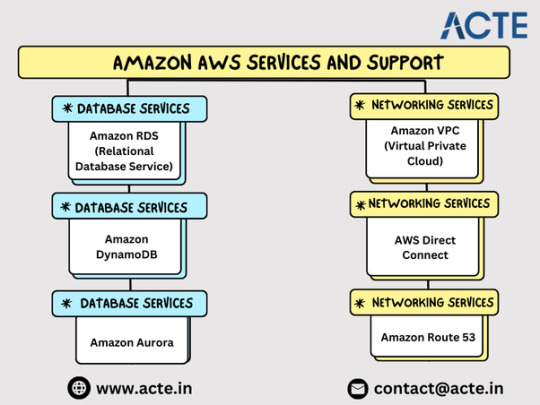
To master the intricacies of AWS and unlock its full potential, individuals can benefit from enrolling in the Best AWS Online Training.
Machine Learning and AI
AWS delivers advanced machine learning and AI capabilities. Amazon SageMaker streamlines model building and deployment, AWS Rekognition facilitates image and video analysis, and Amazon Lex supports building conversational interfaces.
Robust AWS Support
AWS offers tailored support plans to meet varied needs. Basic Support provides essential resources, Developer Support offers business hours access, Business Support includes 24/7 support with faster response times, and Enterprise Support offers dedicated senior support and technical account management.
Training and Certification
AWS provides comprehensive training and certification programs. AWS Training offers digital and classroom courses, while AWS Certification validates technical expertise across different roles like Solutions Architect and Developer.
AWS Marketplace and Partner Network
The AWS Marketplace hosts thousands of software solutions for immediate deployment, while the AWS Partner Network (APN) supports a global community of partners offering AWS-based solutions.
Conclusion
Amazon AWS excels not only in its breadth of cloud services but also in its robust support infrastructure. With scalable compute, versatile storage, advanced AI capabilities, and comprehensive support and training programs, AWS empowers users of all levels to succeed in the cloud computing landscape.
0 notes